Pasta Making in Northern Italy
A Journey to Learn a Traditional Culinary Art
By Jeff Titelius
12/2014
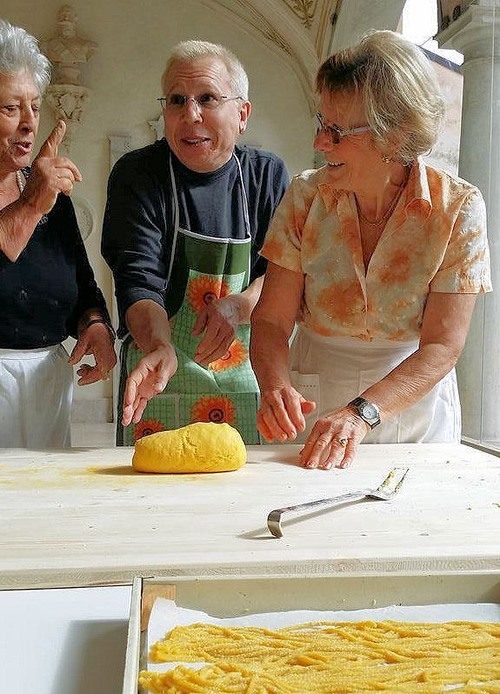
|
|
A gentle scolding on how to knead the dough properly while learning to make bigoli at Villa Mirra in Cavriana, Italy. Photo: Silvia Badriotto.
|
"No, no, no, knead with the palms of your hands, no fingers!" While those words may have sounded draconian at the time, they were delivered with the loving affection of an Italian Mama who happens to take her pasta making very seriously. Fearing for my life, I then kneaded the dough ever so cautiously under those watchful eyes. Yet, this was just one of many memories connecting with locals on a recent journey to the Veneto in northern Italy. Life moves slower in the region, and the time-honored traditions of pasta making are very much alive as are the histories and legends they celebrate. Actually, pasta making has become an art form as well, especially when you consider the need for the precision of Japanese origami in order to properly fold tortellini. Of all the activities that I enthusiastically undertook while in Italy, making pasta with my bare hands was among the highlights.
Tortellini in Valeggio sul Mincio
Our first connection to the pasta culture
was in Valeggio Sul Mincio and the nearby hamlet of Borghetto,
the latter hosting the annual "Festa del Nodo d'Amore" or "Festival
of the Love Knot," celebrated on the third Tuesday in June
of every year. Love knot? Let me explain. It's what Veronese call
their beloved tortellini — nodo d'amore. However, before
we don aprons and pour out sacks of flour, let's take a quick
trip back in time to learn about the "Legend of the Tortellino."
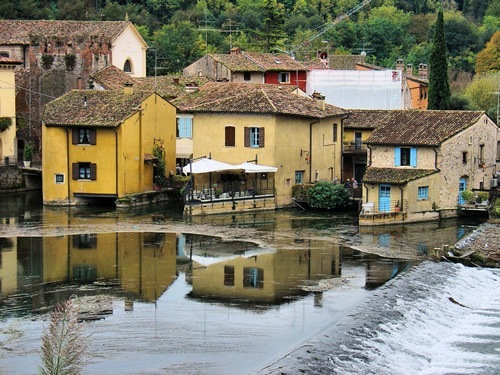
|
|
Borghetto Valeggio sul Mincio: — Home to the Festa del Nodo d'Amore.
|
La Leggenda del "Nodo d'Amore"
As the story goes, it all started back in the 13th century when the Viscount Giangaleazzo, also known as the "Count of Virtue," ordered military encampments along the Mincio River in Valeggio. One evening, he regaled the troops with stories of the beautiful water nymphs who lived beneath the waves. Cursed to the depths of river long ago, the water nymphs were doomed to live out their lives as haggard old witches, but from time to time, they were able to break free of their bonds and dance upon the water's edge by night.
One evening, the captain of the troops, Malco, awoke to discover one of the water nymphs dancing nearby. Instantly captivated by her mysterious presence, he followed one of them along the riverbanks. When she discovered her pursuer, she dropped her cloak in haste revealing herself to be Sylvia, one of the legendary river nymphs. As soon as her eyes met his, they fell deeply in love but she knew that because of the ancient curse, she could not remain above the water lest she become an old witch. Love sick and distraught over her impending doom, she bestowed a gift upon her beloved Malco, a handkerchief tied into a knot symbolizing her eternal love. She turned and disappeared beneath the waters.
The next day, Silvia reappeared as one of the dancers at the Count's party and Malco immediately recognized her. Their affections for one another were soon discovered by the Count's green-eyed cousin, Isabella, who happened to be in love with Malco as well. In a fit of jealousy, she convinced her cousin to have Silvia arrested. But Malco intervened, allowing Silvia to escape, and he is imprisoned thereafter. Later that evening, Isabella went to visit Malco, when suddenly, Silvia re-emerged from her watery depths to be with her beloved. Sensing true love between them, Isabella helped them escape, and they fled to the Mincio River. Just before they were submerged beneath the river's surface, they left behind a golden handkerchief tied in a knot, or the nodo d'amore — the symbol of their undying love.
While the "Legend of Nodo d'Amore" is retold during many holidays throughout the year, it is during the "Festa del Nodo d'Amore" in Valeggio sul Mincio where it really takes center stage. When the festival takes place in June, two rows of tables seating 4,000 diners are stretched across the Ponte Visconteo or Visconti Bridge overlooking Borghetto. More than 550,000 hand-made tortellini are prepared and served to the visitors who come from around the world in order to taste the famous "love knots" of Valeggio sul Mincio, made in honor of the two legendary star-crossed lovers, Malco and Silvia.
Making Tortellini
After we learned about the legend, it was time to make our own golden love knots. We arrived at Al Re del Tortellino, a small pasta factory whose mission is to preserve the traditional ways of making tortellini — by hand. Their motto: "There are things that machines cannot do ... that is the vision of Al Re del Tortellino." And it's not only tortellini they produce. You may also feast your eyes on the homemade bigoli, fettuccini, shells, and many more varieties of pasta that line the cases of a little store in the front of the building. The walls are packed with zesty sauces in a variety of flavors, as well — created using only regional ingredients.
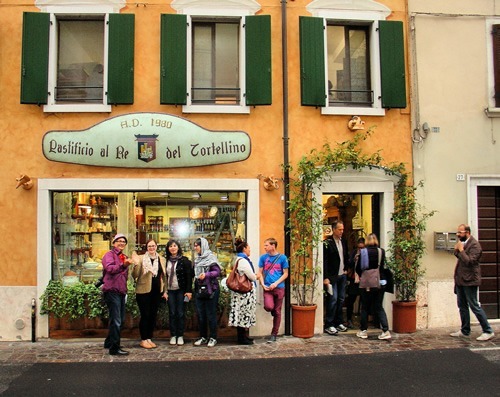
|
|
Al Re del Tortellino Pasta Factory in Valeggio sul Mincio, Italy.
|
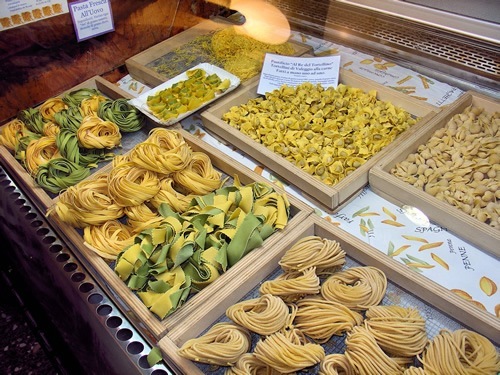
|
|
Feast your eyes on all of this fresh pasta at Al Re del Tortellino, Italy.
|
After our brief tour, we ventured into the back where we could see a table of six Italian women, none of whom spoke any English, hand folding the little knots of love — just as their ancestors have done for centuries. Quickly we donned our aprons as instructed, washed our hands, and went to work. It all begins with the pressing machine that squeezed out humongous sheets of pasta — a process repeated over and over and over ... until the desired thickness, or rather thinness, is attained. Then, the sheet is spread out onto the table and scored into 2 inch by 2 inch squares. A small spoonful of precooked meat or fresh cheese is placed in the center. The folding begins, and it's no easy task.
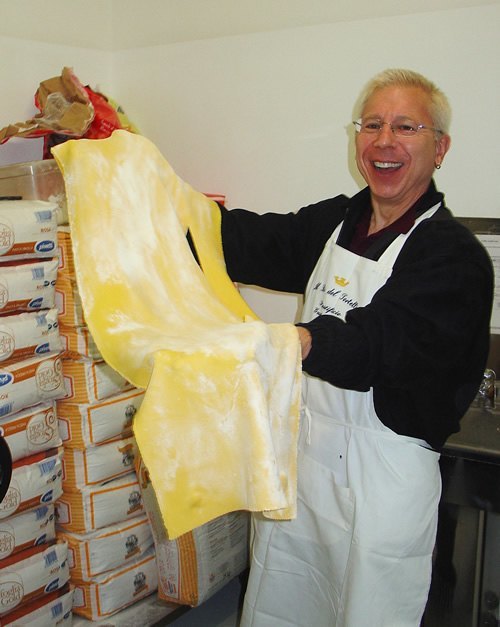
|
|
Giant pressed sheets of pasta emerge from the pressing machine and are ready for the table at Al Re del Tortellino in Valeggio sul Mincio.
|
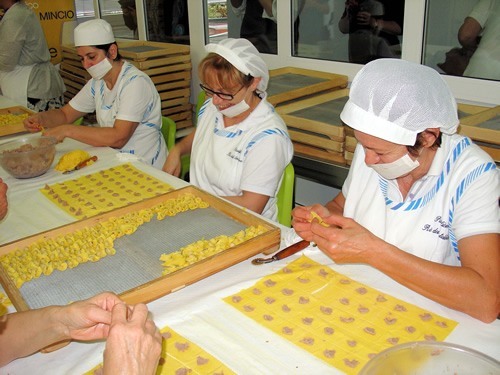
|
|
Folding Tortellini at Al Re del Tortellino just as their ancestors have done for centuries in Italy.
|
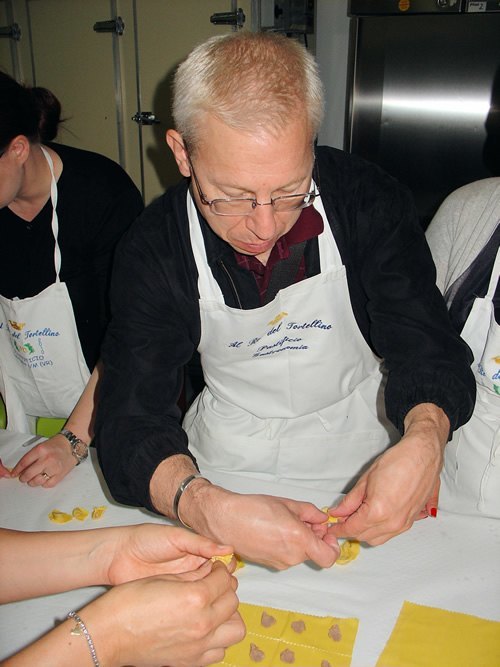
|
|
Learning the art of folding tortellini at Al Re del Tortellino.
|
Carefully, you must fold the squares in half, sealing in the filling, and then with your index fingers and thumbs, grab the ends, pinch the filling to the center and fold them one on top of the other, somewhat resembling a collared shirt. "Ecco" (Voilà), as Italians say, the tortellino. While it took three attempts before I finally succeeded, my newly honed skills were put to the test as I picked up square after square and created my own little love knots. In recognition of our hard work and efforts, the Tortellini King stopped by to commend us on a job well done, even if they likely weren't up to royal standards.
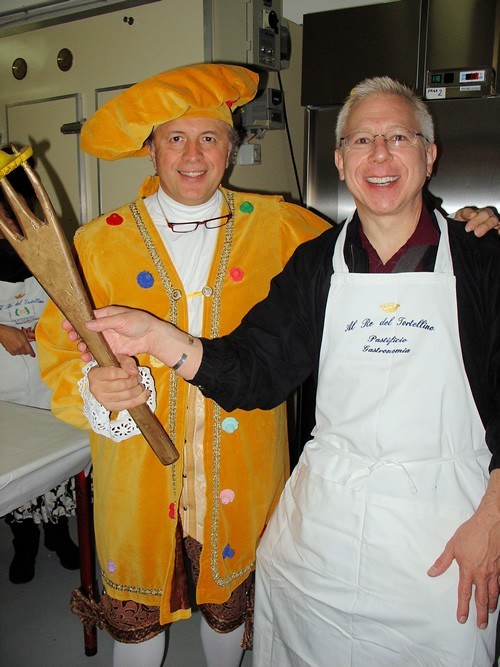
|
|
Meet the Tortellini King at Al Re del Tortellino.
|
The Recipe
Making the pasta is simple and requires few ingredients, but unless you have a manual pressing machine to roll the dough to the necessary fineness and texture, you'll need a rolling pin and very strong arms. I've included the recipe from Al Re del Tortellino below.
Dough:
-
2 cups flour
-
5 eggs plus one yolk
-
Salt
-
Pinch of nutmeg
Form a well in the center of the flour and pour in the eggs, a teaspoon of salt, and an optional tablespoon of extra virgin olive oil. Begin mixing the dough with a fork. Use your hands to combine all the ingredients into a ball of dough. Roll into thin sheets, 1 mm. in thickness. Score into 2 inch by 2 inch squares. Place a small amount of filling in the center and fold as described previously.
Filling:
-
5 oz. Italian stewed beef
-
2 oz. pork
-
2 oz. ground veal
-
1 oz. chicken livers
-
1 egg
-
Butter
-
Salt
-
Nutmeg
-
Sage
-
Onions, carrots, and celery
-
Splash of white wine
-
Optionally: Improvise with additional herbs to your taste
Combine meats and vegetables and cook over low heat while adding wine from time to time. Let cool. Add one beaten egg to combine the ingredients. Add a pinch of nutmeg.
Drop your love knots into boiling water and cook for 3 minutes. You'll never go back to store-bought tortellini again.
Special thanks to Marianna and the entire team at Al Re del Tortellino for hosting us in this class. If you're interested in attending one of their cooking classes, and I strongly recommend it, visit them online at AlRedelTortellino.it for more information.
Buon Appetito!
Bigoli in Cavriana at the Villa Mirra
Our pasta making pilgrimage continued to the Villa Mirra in Cavriana, a province of Mantua in the Lombardy region of Italy. Dating back to the 13th-century, the Villa Mirra is imbued with the history of the Gonzaga family, as well as the unification of Italy. Here, the ceremonial "Surrender of the Flags" took place following the Battle of Solferino, which ended the Austrian dominance of northern Italy on June 27, 1859. The villa was built upon the ruins of the formidable Gonzaga Fortress, most of which was demolished in 1771, with some vestiges remaining on the hill just behind the villa.
While the villa had once been home to a number of noble families throughout the 19th century, it was Mirra Pastore and her Italian husband Italo Silprandi who took ownership in 1883, and gave the villa its name. Sadly, the Silprandi's met with financial hardship, and in 1974 the villa was auctioned off. Four years later, it was purchased by the Municipal Authority of Cavriana and today, it houses the Archeology Museum of Mantua, a wine museum, and the Museum of Rural Life presently under construction.
The Archeology Museum is a fascinating complex that retraces history as far back as 200,000 years ago through its locally discovered artifacts, including the mostly intact skeletal remains of a 14-year-old Veronese prince who lived 20,000 years ago. It's definitely worth a stop if you're visiting Cavriana.
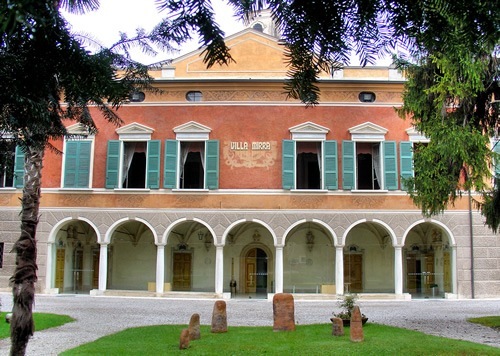
|
|
Villa Mirra Exterior.
|
The Bigoli
With appetites mounting, we finished our tour and gathered in the portico where Teresa and Dario Darra, local millers, and a few of their friends, were setting up for our lessons in making bigoli — a thick Italian spaghetti. Little did I know at the time that folding tortellini was child's play compared to the rigors of making spaghetti. I never realized how challenging it would be to knead the dough, but the bigoli created from our labor turned out be a scrumptious reward.
As we surrounded our wooden workbenches, Teresa presented the ingredients: semolina (a coarse yellow flour), regular white flour, eggs, olive oil, and salt. With small mountains of the blended flour before us, Teresa formed wells in their centers and dropped in a tablespoon of olive oil, a generous pinch of salt, and one egg. With fork in hand, we mixed our own mounds until the ingredients homogenized. Then the real work began.
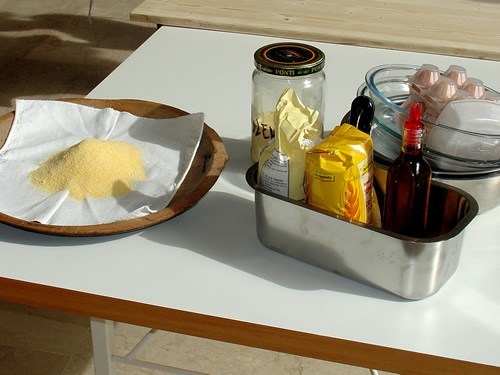
|
|
The ingredients.
|
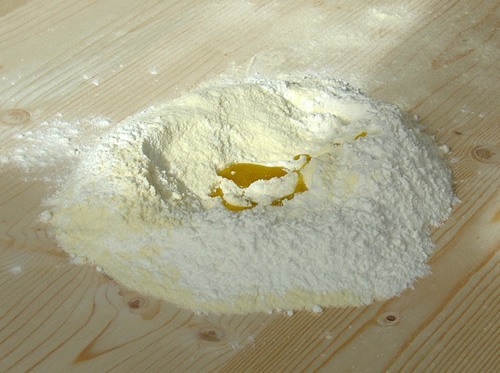
|
|
Mounds of blended flour and olive oil.
|
We started to knead our new balls of dough by folding, pressing, folding, and pressing repeatedly until it became elastic — no small feat! At first, Teresa made it look so easy, but she had the powerful and dexterous hands, wrists, and forearms — testaments to many years of making pasta. After her demonstration, Teresa monitored our progress and ensured that we were kneading the dough correctly, and if not, a gentle scolding was to be had. We all took turns until our dough reached the ideal consistency. Time to make the bigoli.
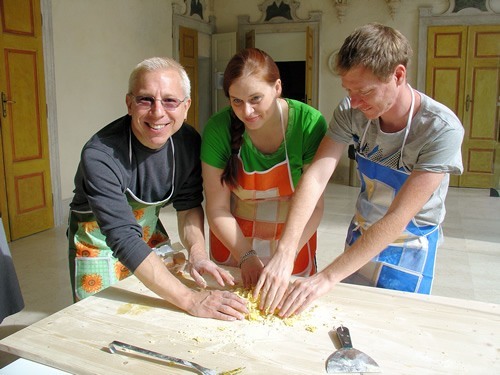
|
|
Mixing the raw ingredients.
|
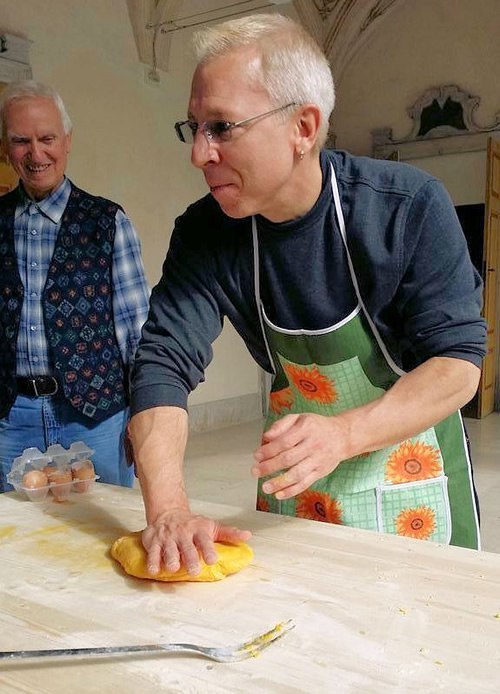
|
|
With fierce determination, I was determined to get it right! Photo: Silvia Badriotto.
|
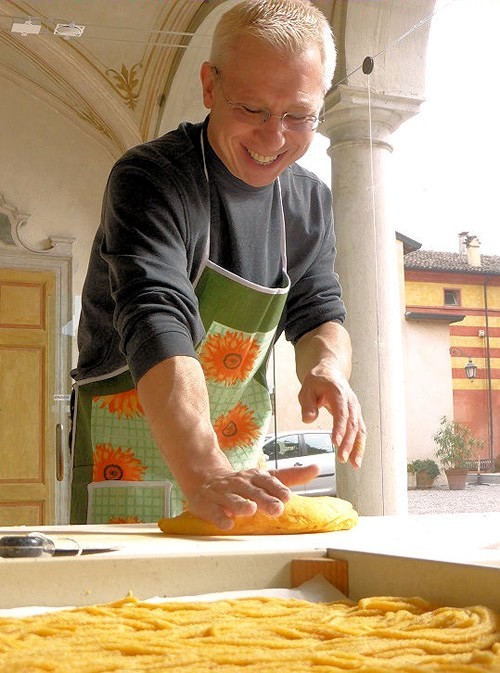
|
|
I'm finally getting the hang of this. Photo by Saskia Balmaekers.
|
While Teresa managed combining the raw ingredients, it was her husband Dario who oversaw operations at the antique bigoli maker, a wedding present to Teresa's grandmother in 1910 and later passed down to her and Dario. Carefully, Dario filled the neck of the machine with smaller portions of dough, then sealed it with a lid and giant corkscrew. Slowly, he turned the handles forcing the dough through the bigoli grate at its bottom. Things got a little tricky here. As the newly-formed bigoli emerged, we had to sift it gently with cornmeal to prevent it from sticking together. As it turned out, this was just as demanding as kneading. Soon we all got the hang of it, and the bigoli continued to flow, filling the basket below. We all took turns turning the corkscrew and sifting the fresh pasta.
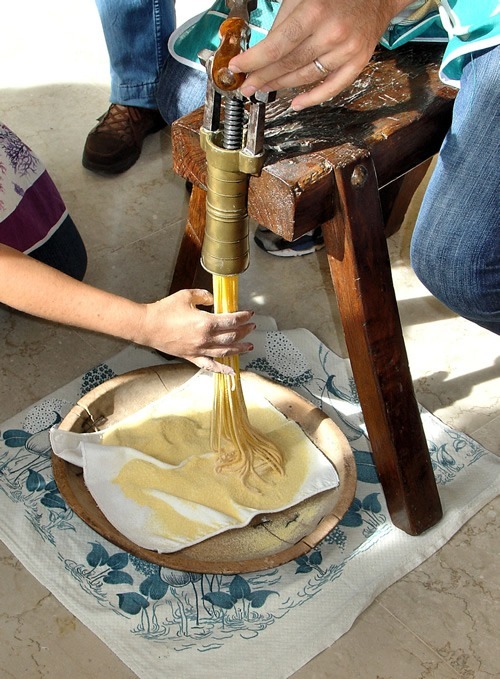
|
|
Finally, Bigoli emerges from the antique pasta machine at Villa Mirra.
|
By the time we finished the pasta making ritual, we had amassed quite the bounty. Time to immerse the pasta in huge steaming pots of boiling water. While the pasta cooked, we retreated to the wine museum, where one long table was set up for our lunchtime meal of fresh pasta. We gathered together in a scene straight from an Italian family setting as you might imagine it to be. The matriarchs, the patriarchs, the family, and friends all coming together at the table — our entire Villa Mirra family — sharing wine, stories, laughter, and good food. Does it get better than this?
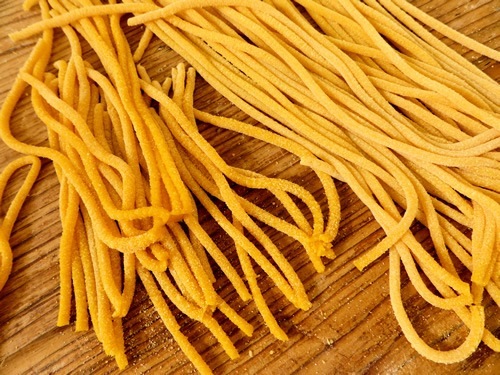
|
|
Fresh bigoli waiting to be cooked. Photo: Saskia Balmaekers.
|
"Buon Appetito!"
Through all my years of traveling, it has always been these kinds of experiences I so desperately crave — connections with cultures and traditions foreign to mine, opening my eyes, and expanding my horizons to worlds unknown.
Did I mention how delicious our meal was?
I would like to thank the Comune di Verona, Comune di Cavriana, the Comune di Valeggio sul Mincio and Al Re del Tortellino for your generosity in hosting me on this culinary adventure. Of course all opinions expressed are mine alone.
Jeff Titelius is a travel writer and publisher of EuroTravelogue.com — chronicles of wondrous journeys throughout Europe. As Jeff says, “"Wherever the roads or rivers may lead, I seek out cultural connections with places and people." In addition to his own website, Jeff has appeared here on TransitionsAbroad.com, Insight Guides, NRK-Norwegian TV interview, Viking River Cruises brochures, ItalianTalks.com, and he was a guest journalist on NRK-Norwegian TV’s series, “Sommeråpent.” — among others.
|
